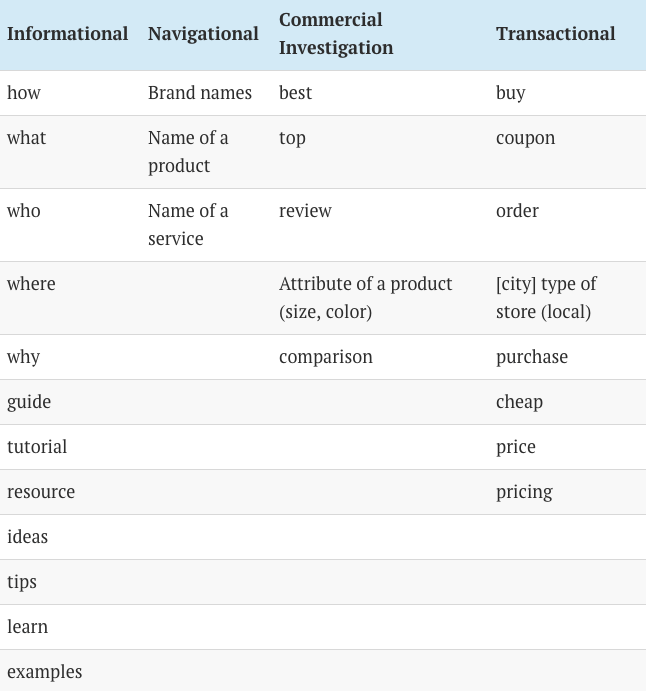Four Types of Seach Intent + 4 C's of Search Intent
The role of search intent in a great content strategy.
Search intent is a foundational aspect of SEO (search engine optimization). How often do you think that people create a website for their business and then consider “how can I get my site to rank higher in search results?” I would argue that this is almost always what happens for new website development and ongoing content creation. But, I want to challenge you to rethink how (and why) you create content. Of course, the why is primarily to increase traffic and increase sales – but what is the purpose of each specific page or piece. What do you want the user to do? This will all be defined in your content strategy.
Creating a great content strategy starts with understanding the way all people use search engines. So before you begin creating content, you will want to distinguish the search intent for each of your pages. Below we outline the standard types of search intent, keyword usage, and the 4 C’s of search intent.
What is search intent?
Search intent is, very simply, the reason or purpose for the user’s search. We break this down into four types of search intent: informational, navigational, transactional, and commercial investigation.
Informational Search Intent
Informational searchers have a specific question they want to be answered. Like, “what is search intent all about and how can it help my SEO?” Wanting to know the answer to this question would be an excellent reason you are here – because that is the search intent that we have identified as the purpose of this post.
Navigational Search Intent
Navigational searchers are looking for a specific page. They clearly know what site or page they’re looking for but aren’t sure of the specific address or have found that searching a shorter version of the website address will display the site as a search result. For example, you might have searched ‘bring results’ knowing that Google will provide a link to bringresults.com.
Knowing this, we can be confident that we will not rank for certain terms. People who search ‘Facebook’ are looking for Facebook.com, not your blog post on how to use Facebook.
Transactional Search Intent
Transactional users are searching with the purpose to buy something. They know which item they are looking for, or possibly only the type of item they are looking for, and they are prepared to make a transaction. Usually, this user has already done the research and knows exactly which item they are seeking to order. If they haven’t already done the research, they might still be in this stage of search intent:
Commercial Investigation Search Intent
In a commercial investigation, users have the intention to buy in the near future and are using the web to research which product would be best for them via product reviews, prices, product comparisons, and descriptions.
Understanding keyword usage in search intent.
Ahrefs.com has a great post on search intent with this diagram to help show you how to use certain keywords to modify your page’s search intent.

The Four C’s of Search Intent
Establishing the type of search intent will aid in defining what is referred to as the four C’s of search intent. This added layer of search intent helps to clarify what type, style, format, and angle to use when creating high-ranking content.
Content Style
Content style refers to the dominant style of content in the search results for a specific search query. This is most commonly web pages but can also be videos. It is integral to identify the way most people prefer to consume certain types of content. For example, users who are interested in learning how to speak with a British accent would more likely watch a video where they can hear and see someone model dialect than to read about it.
Content Type
Content Type refers to a blog post, a landing page, a product page, or a category. A good example of how this affects search intent would be the search results returned for “Buy Shoes” vs. “Buy CROCS”. “Buy shoes” will result in web pages, specifically online stores, that offer a variety of different shoe types and brands. “Buy Crocs” will result in product pages for Crocs brand shoes.
Content Format
Content format applies mostly to informational pages. Common format examples include how-to or tutorial style, news articles, opinion pieces, lists, or product comparisons. It’s good when creating content to research what content format is currently being successful in search rankings. It’s a good indication of how the user prefers to receive information on that topic.
Content Angle
There is much to say about content angles but essentially this is directing content at a specific buyer/lead persona. Drawing them in with a relevant persona objective, user interest, or time significance. For example, marketing your product as “wedding shoes” seeks out buyers with weddings as their specific user interest. Or “summer activities” targets users with time significance.
Final Thoughts
Utilizing all aspects of search intent, ask yourself these questions whenever you are in the beginning stages of content creation. It will help drive your decisions for the proper type of content to create and will lay a foundation for excellent content that inherently possesses the proper keyword usage based on what google shows you is already performing.
What type of page is this?
Who am I trying to reach, or what do I want them to do?
What style fits best with my objective and my goals?
What style/type/format is currently being successful in search rankings?
For more information about SEO download our free resource on SEO Best Practices!
